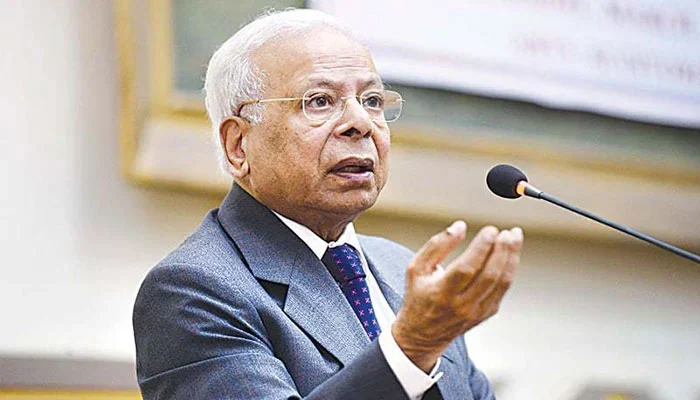By Ishrat Husain
Published in The News on June 03, 2025
THE finance minister recently announced that the next budget would be a ‘strategic’ budget rather than making the math work.
The annual budget is not only an instrument of fiscal policy (taxation, levies and expenditure choices ) but also directly or indirectly affects monetary policy, trade and exchange rate policy, private investment, poverty reduction, human capital formation, etc.
This article helps lay out the contours of a transition budget that consolidates the recently achieved macroeconomic stability and paves the way towards a trajectory of long-term, inclusive and sustainable growth. The last few weeks have been marked by a positive change as the country became united because of the actions of an aggressive neighbour, minimising political fragmentation. This political stability is the much-awaited and desired precondition under which tough, unpopular but inevitable economic reforms can be implemented — and this opportunity should be fully availed.
In addition, the outcome of the FY25 budget in terms of positive primary fiscal balance, despite the FBR revenue shortfall and the possibility of the external current account ending up slightly surplus, provides a solid base for the next year. Implementing some of the structural benchmarks agreed upon with the IMF, such as the National Fiscal Pact and including provincial finances in the revenue mobilisation strategy for the first time, is the beginning of widening the tax base in the medium to long term.
The main challenge, in the coming year, however, is to strike a balance between the increased allocation for defence and climate change initiatives while preserving social protection, education and health spending.
Given the aforementioned positive factors and challenges, the first step should be to lay out a medium-term policy roadmap in parliament while presenting the budget for the direction in which the economy would be steered in the next two years and the post-2028 period.
During the next two years, we are obligated to comply with the conditionalities agreed with the IMF under the Memorandum of Economic and Financial Policies, and the room for manoeuvrability for policymakers will remain limited, but the degree of freedom would be enhanced after 2028. Such a roadmap is essential to minimise uncertainty and assure potential investors about the future environment in which to invest. We would not repeat here the ongoing reforms of digitalising and documenting the economy and rightsizing the government as well as reforms in the energy sector, import Tariffs, SOEs, regulatory overlay, FBR, etc, that have to be part of the roadmap.
However, we touch upon three additional ingredients which require priority attention. First, the emphasis under the IMF programme has been rightly placed on financial variables — fiscal, monetary, exchange rate and current account.
The primary factor driving frequent balance-of-payments crises is the underlying deficit in the productive sectors of the real economy — agriculture and industry. This deficit reflects a mismatch between the aggregate demand generated by economic growth and the total domestic production, leading to a spillover into import demand. Since reducing this deficit will take time, it is essential to address it now.
In agriculture, which has strong forward and backward linkages with industry, retail and wholesale trade, transportation and exports, the decline in the output of major crops, particularly wheat and cotton, must be reversed. At the same time, the country needs to substitute imports of oilseeds, pulses, milk, and other such items, which currently account for an outflow of $7 billion to $8 billion annually. This can be achieved through a targeted package aimed at boosting the productivity of small and medium farmers. These farmers have been unable to increase their output largely because the volume of agricultural credit for necessary inputs has not kept pace with growing demand.
The government was preempting the banking assets to meet its budgetary deficits. As these deficits are reduced over time, the banks must be incentivised to deploy digital tools and innovative methods to reach out to this underserved segment. The threat of the Indus Waters Treaty forces us towards the efficient and equitable use of irrigation water. Contract farming between the farmers and processors has created a silent revolution in maize, potato, milk, fruits, etc — and needs to be encouraged in other crops and meat, poultry, etc.
Industrial policy, which has been under preparation for quite some time, should be announced with an emphasis on export orientation, medium and high technology-intensive internationally competitive products, attracting FDI flows, joint ventures, particularly relocation of Chinese enterprises, and creating employment opportunities for the youth. Skill formation, technical and vocational training, apprenticeship programmes, industry-academia partnership should be an integral part of the policy.
Restructuring SMEDA and improving SME financing, ensuring the full utilisation of Special Economic Zones (SEZs) and Export Processing Zones (EPZs) and developing intermediate goods industries, such as steel, petrochemicals, and refineries, that support downstream industries should all be key components of a comprehensive industrial policy.
Second, allocations for Research and Development (R&D) in public sector universities and research institutes, particularly in agriculture and industry, have been dismally low, despite these institutions having significant untapped capacity. With appropriate incentives and improved governance structures, these institutions could play a critical role in addressing our productivity and competitiveness challenges. It is worth remembering that the significant increases in cotton, wheat and rice production up to the 1990s were largely the result of focused efforts by these very institutions.
R&D funding should primarily be channelled through competitive research grants, and researchers should be allowed to commercialise their patents and inventions. In addition, private sector firms engaged in research in pharmaceuticals, engineering goods, electronics and other technology-intensive products and services should be offered tax credits to incentivise innovation.
Third, the real purchasing power of the middle class has eroded during the last three years due to high inflation, stagnant incomes and wages, exorbitant taxation, depreciating currency and soaring utility bills. They can no longer afford good schooling for their children within their disposable incomes. The result is the exodus of highly skilled professionals depleting the ranks of academic and research institutions, as well as private-sector firms including multinationals at a time when we want to bring in additional qualified expatriate Pakistanis to benefit from their expertise to give a boost to the competitiveness of our industry.
Some estimates suggest that the middle-income group pays nearly three times more in taxes than the business sector. In the upcoming budget, income tax on the salaried class should be reduced. At the same time, the government should announce a five-year roadmap to gradually lower the General Sales Tax (GST) from 18 per cent to 12 per cent and reduce the corporate income tax rate to 25 per cent. Utility pricing should be rationalised, and the government should transition toward targeted subsidies to better support vulnerable populations.
Banks must also be encouraged to expand consumer financing for mortgages, automobiles and durable goods, as the credit risk associated with middle-income borrowers is relatively low.



